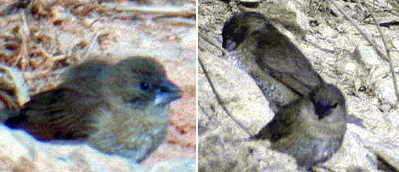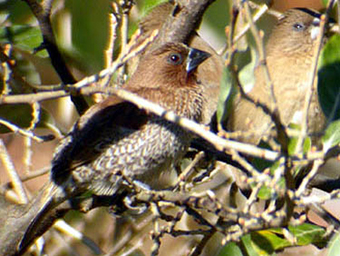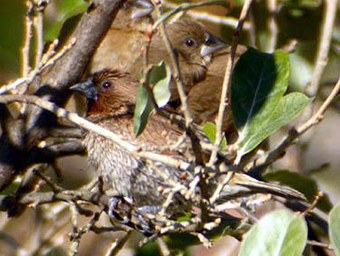Nial Moores, Birds Korea, 2004

October 26th 2003 saw strengthening southwesterly winds affect the whole West/Yellow Sea, including the far northwestern island of Socheong (located at approximately 37 D 30' North and 124 D 40' E). These winds further increased to Beaufort force 7 or 8 by the morning of the 27th, and persisted until the 28th, when they strengthened still further (to gale-force 8 or 9) before swinging round to the northwest. The winds were accompanied initially by locally high visibility (in excess of 100 km), gradually increasing cloud, and then a period of heavy overnight rain with thunderstorms.
Walking towards the southwestern end of the island on the afternoon of the 27th along a cliff-side path through thick grasses and dense secondary growth, a tight group of seven very small brown passerines were watched flying up out of the vegetation eastward - initially with the naked eye at a range of about 30 m.
At first suggesting Chinese Penduline Tit Remiz consobrinus, even brief flight views immediately confirmed that that these were rather a species of munia - based on (1) their very small size; (2) their apparently massive grosbeak-type bills; and (3) their short tails.
The group, picked up by the strong winds, hurtled very rapidly out of sight around the corner of the cliff - finally being relocated at least 30 minutes later as they dust-bathed and fed on an unmetalled track about 800 m east of the first sighting.

Although views were fairly brief (lasting less than one minute) and distant, a series of digital images were taken through a mounted telescope. These images confirm several features noted in the field and confirmed their identification as Scaly-breasted Munia Lonchura punctulata. All of the seven were (4) warm brown in coloration, darker above than below, with (5) a variably darker head and throat contrasting with a paler hindnape collar, and at least three of them (presumably adults) also (6) showed stronger chestnut tones to the closed wing, as well as (7) patterned grey and off-white rumps, with a grayer upperside to the uppertail coverts or tail. All seven had (8) massive bills which were dark blue-grey, which in some (the plainer-looking juveniles/immatures) appeared darker distally, or with a darker upper mandible. (9) Diagnostically all, to a greater or lesser extent, showed some distinctive scales on the underparts. This scaling, the extent of which is apparently determined largely both by age and subspecies, is regarded as a diagnostic feature of Scaly-breasted Munia, and is not shown by the only two other species of munia occurring naturally in the wild in eastern China: White-rumped Munia Lonchura striata and Black-headed Munia Lonchura malacca. It was most defined, extensive and dense in the two most brightly coloured adults, apparently covering the whole of the underparts, and being comprised of dark grey crescents with some browner internal markings, while in one (either a poorly marked adult or perhaps a subadult), the scaling appeared sparser on the lower belly, and the ventral area appeared buffy. In the plainest individuals (the remaining four), much of the underparts appeared buffy-brown, with variably buffy pectoral patches, and scales showing strongest on the flanks and undertail coverts. In addition, (10) all lacked any white in the plumage (further ruling out White-rumped Munia), and (11) none showed obvious black anywhere in the plumage (ruling out at least adult Black-headed Munia).
Additional features noted included (12) blue eye-rings of varying strength and (13) the call - a nasal, toy trumpet-like "chewp"or "zhuu" given on several occasions, just before flight and during take off.


Following these brief views, a further hour was spent searching for the munia flock, and considerable effort was again invested unsuccessfully on the 28th in the search, by which time winds had swung around to Force 8 or 9 north-westerlies.
In calmer conditions shortly after dawn on October 29th, in the eastern part of the island (about 2 km east of the original sighting), either four of the original seven or a new group of four Scaly-breasted Munia were found, this time feeding actively on seed-heads, before roosting and sunbathing in a small tree. Much closer views were obtained (down to about 10 m) over a one-hour period, and a series of about 20 digital images were taken. This group was comprised of one full adult and three juveniles/immatures, and additional features noted included (14) very faint paler streaking on the underparts of the adult, and (15) a reddish brown iris colour. The flock could not be relocated later that afternoon, or on subsequent dates, despite much searching.

Photos © Park Jong-Gil.
Although October 27th 2003 saw the first record of the species (even of the genus) for the Korean peninsula, remarkably a flock of 4 was also found the next day (October 28th), by Park Jong-Gil, on Hong Island - approximately 400 Km south-southwest of Socheong Island. This group was also well-documented.
Intriguingly, the images seem to suggest that at least the well-photographed Hong Island adult was perhaps paler and more heavily pale-streaked above, and that they all showed less blue eye-rings than the individuals seen on Socheong Island. These apparent differences could either have been a product of light conditions, or could hint at different origins of the birds.
Either way, the Hong Island record supports the presumption that the Socheong birds were naturally occurring rather than escaped cagebirds; and additionally, as there were no other observers known to be birding on any of the western islands - or even birding anywhere along the length of the west coast of the country on those dates- that these birds were also very likely part of a major influx of the species into South Korea, carried across the West Sea/Yellow Sea by very strong southwesterly winds. This in turn suggests that the series of records made on October 27th, 28th and 29th should be best considered as three, rather than two, records: the first, second and third Korean records of the species - with 15 individuals involved.
The Scaly-breasted Munia is generally considered to be a resident species across much of its huge natural range, spanning much of the Indian subcontinent and Southeast Asia as well as southern China (perhaps north to the Yangtze). It was first recorded in Japan's southern Okinawa Islands in early 1970s, either by natural colonization or by introduction (Brazil, 1991), and has subsequently increased there. It has not yet been recorded in Hebei Province, northern China (J. Hornskov in lit.).



